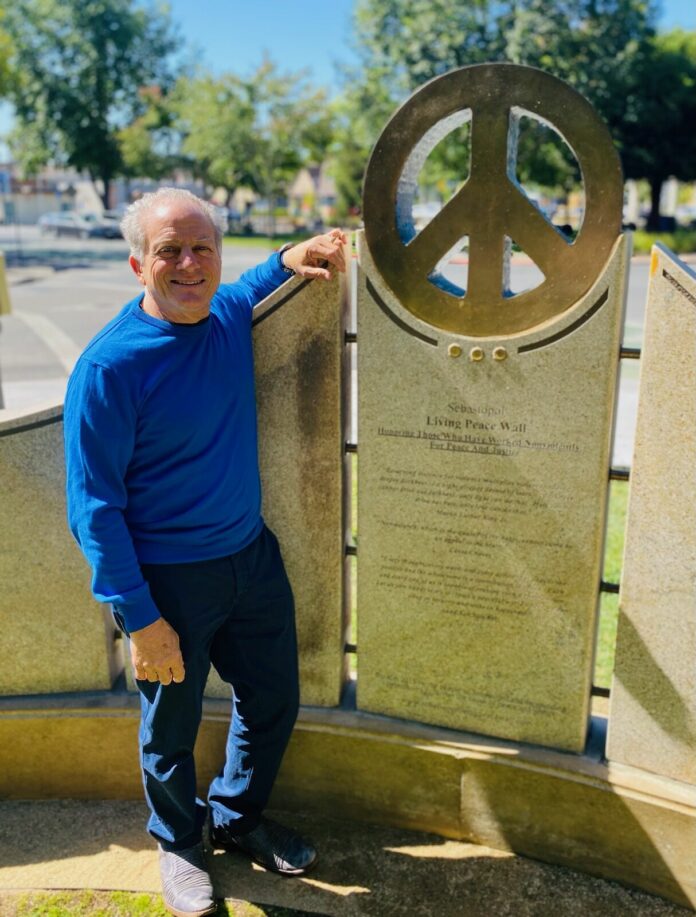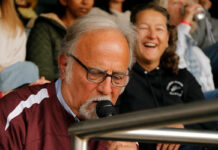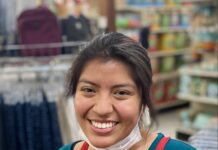There are a few iconic spots around the west county that you may be inclined to take a visitor to. We do it so they can better understand and appreciate the place, and in no small part as a way of showing off. Armstrong Woods, Bodega Head, the schoolhouse in Bodega that was featured in “The Birds,” the Apple Blossom Parade, the Fourth of July celebration on the football field, Mimi’s, Hardcore Espresso, a Peacetown gathering, all come to mind.
In recent years, the Living Peace Wall, right there in front of the Rialto, and the ceremony each year that honors the four individuals who go up on the wall each year, has joined that list of iconic west county sites and ceremonies.
The energetic Michael Gillotti had the idea for the Living Peace Wall. He is the guy who wouldn’t stop advocating for it until it came to be, and the guy who sustains the project today. With the induction of this year’s crop of peacemakers about to be honored on September 11th, I thought it would be a good time to get to know Michael, and the wall. We met the other day at the wall, and then sat in the plaza for a while.
Me: Where and when were you born, Michael?
Michael: Des Moines, Iowa, in 1948. I’m 73. A true baby boomer.
My dad was a carpenter, and my mom stayed home. There were six of us kids. Three boys and three girls.
Me: Sounds Catholic to me.
Michael: Totally Catholic. I went to Catholic grade school, Catholic high school and then even on to a Catholic college and seminary.
Me: Work? Family?
Michael: I was a nurse for quite a while, but retired years ago. Later I had a manufacturing company here in Sebastopol. We made massage tables and chairs. That was partly my dad’s influence.
I’m married for 39 years to the same woman, and we have one daughter who teaches yoga and meditation, and Ayurvedic medicine. She grew up with me doing yoga every day, and my wife who taught meditation for years. She’s clearly a product of both of us.
Me: So back in the seminary, what changed?
Michael: Well, I was headed to the priesthood. I was actually shocked I never made it, but the Vietnam War changed everything.
When I entered college seminary in 1966, I was a much different person. I believed that if the government said we had to go to Vietnam to stop communism, then that’s what we had to do. But somewhere in my sophomore year, the reality of the war was revealed to me. An older seminarian who had returned from Vietnam started my questioning of the war. Oddly, my back up plan to that point, if the priesthood didn’t work out, was to join the Marines and the war effort. This guy really started turning me around.
Me: So how did you get out here?
Michael: The seminary was in Dubuque, Iowa. After four years, I graduated and a week later headed out for the Haight. I wanted to be a part of the counterculture and also do my two years of service as part of my CO (conscientious objector) requirements. It was the first year of the lottery in the draft, and I drew number 33. They were taking just about everyone up to number 150. My service was mostly at Mary’s Help Hospital in Daly City. It was years later, that I actually became a nurse.
Me: Did you live in the Haight?
Michael: Near it. I actually moved into the Fillmore, to be in a Black neighborhood. I thought I’d grow to understand their challenges and that way I’d be better able to help as a priest someday. It was my way of being in the seminary while being in the bigger world. I hadn’t dropped out of the seminary, but almost got kicked out.
Me: How?
Michael: I got into trouble for helping lead a demonstration in support of the few Black students on campus. They were being forced to shave off their beards and goatees. They were just about all on the basketball team. The bishop got wind of it, and was on the verge of kicking the lot of us out. In the end we all got a stern warning.
Me: Seems like you were getting into John Lewis style “good trouble.”
Michael: You know, I met John Lewis once. It was at the 50th anniversary of the March on Washington. I saw a bunch of people standing around him and slid in to shake his hand and thank him. It was the highlight of my trip.
The Berrigan brothers, Daniel and Philip, became my role models as radical priests. That’s the kind of priest I wanted to become.
Me: Are you still connected to the church?
Michael: No. I’m more into eastern religious thought and practices.
Me: Tell us more about the Peace Wall.
Michael: It really started when I became a CO. It’s an extension of that.
When we fumbled into Iraq, I was horrified. I could see how it was going to unfold.
Me: So having Congresswoman Barbara Lee as one of this year’s honorees is all the more poignant.
Michael: Absolutely. As the sole congressperson to oppose our involvement, she’s one of my heroes. The whole Peace Wall committee nominated her. We usually take nominations from the public, but occasionally, when we feel strongly about someone, we put them up for the honor ourselves.
I just saw the documentary about her at the Rialto. It’s called “Speaking Truth to Power” and might still be there. I cried a number of times. She’s a courageous and compassionate woman. We’re thrilled that she’ll be coming on the 11th.
The Iraq/Afghanistan war was my motivation for doing something like the wall. I was trying to figure out how I could help keep men and women from coming home in body bags, or returning traumatized with PTSD and suicidal.
I thought, what if we could give a voice to the peacemakers? That was the underlying motivation.
The second part is that it’s thankless work being a peacemaker. We needed to find a way to acknowledge this critical work. This is an opportunity to encourage the work and show our gratitude, and to inspire others to get involved.
Me: Are there other walls like this any place else?
Michael: Not yet. I hope we’ll inspire other communities.
You know, it’s called a Living Peace Wall. It’s a dynamic monument, not static. It’s infused with life. That’s part of what makes it unique.
Me: Tell us about the ceremony itself.
Michael: It’s always on the second Saturday in September. Just by chance, it falls on 9/11 this year. That’s timely in light of our withdrawal from Afghanistan, as well as having Congresswoman Lee. It was three days after the attack on 9/11 that she voted against going into a war there. She had the courage and foresight to see the catastrophe that it has been.
We honor one higher profile individual each year, who has been devoted to seeking peace and non-violence, together with three local people who, though lesser known, are still deserving of recognition.
Me: There’s been a lot of buy-in here in Sebastopol for this project.
Michael: Indeed. It cost $20,000 to make this wall a reality. People here have contributed in all sorts of ways. It costs another two thousand a year to maintain it and put on the ceremony.
I’m grateful too to the Sebastopol City Council for allowing us to build the wall on city property, right in the heart of town. Some wanted the wall in Ragle Park, or anywhere but the very center of town, but the council eventually agreed with me about making it centrally located and have been supportive ever since.
Me: What else are you up to?
Michael: I’m also a singer/songwriter. I’ve cut seven albums of original music, and I’m working on my eighth. There’s a bunch of anti-war songs, but lately more spiritual songs and love songs. I guess I’m not so angry anymore. I also like to write and am working on a novel, and I travel to Italy every year. I’m working on my Italian. Both my wife and I are full blooded Italians.
Me: Okay. So if you had a few lira to donate someplace, who would you be giving it to?
Michael: (he answers this in a nanosecond) The Peace and Justice Center, and Amnesty International. Doctors Without Borders, too.
Me: Hey, no surprises there.
Michael, many thanks for spilling the beans here, and of course for all your hard work and devotion to the Living Peace Wall. You have good reason to be very proud of it and what it represents.
You can learn more about the Peace Wall and view a list and bios of previous honorees by going to sebastopollivingpeacewall.com and by viewing an eight-minute documentary film at this link:
Https://youtu.be/Mh7BqHYjNEE
Here are Michael’s choices for worthy charities:
The Peace and Justice Center
467 Sebastopol Ave. Santa Rosa 95401
Pjcsoco.org
Amnesty International
Amnestyusa.org
Michael didn’t ask for contributions to the wall, but just in case you are interested:
The Sebastopol Living Peace Wall
708 Gravenstein Hwy N. #317
Sebastopol, CA 95472
Sebastopollivingpeacewall.com









